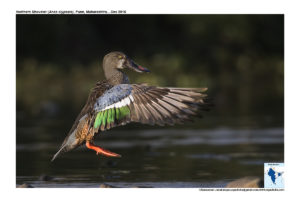Northern Shoveler

Northern Shoveler Anas clypeata
Etymology:
- Anas : Latin word for Duck
- Clypeata : Latin word clypeatus shield-bearing derived from clypeus -shield
Vernacular Names: Sind: Alipat, Gaino, Langho, Hindi: Tidari, Punana, Tokarwala, Girah, Sans: Khat hansak, Pun: Balchi, Mirshikars: Sankhar, Ben: Panta mukhi, Kunte hans, Ass: Khantiya hanh, Nak dungara, Mani: Khara, Nepal: Dho baha, Sankhar(M), Khikeria sankhar (F), Guj: Gaino, Gayano, Pagtichanch, Kutch: Phatphaje, Mar: Thaptya, Ta: Mattimukh cheravi, Mookara thara, Te: Chamcha muti batu, Mal: Thara, Sinh: Seruwa
Distribution in India: Wide spread winter visitor in India.
Description: Size of 44-52 cm. Large, distinctively-shaped bill ,in flight exhibits green speculum and pale blue upper wing-coverts contrasting with brown primaries and, in male, black back with broad white braces. The breeding male is further distinguished by distinctive green, white, red and black pattern on underparts. Male has female-like eclipse plumage, but differs in being more uniformly redder brown and retains distinctive wing pattern Female has orange legs; in non-breeding plumage is overall brown with paler fringes to feathers, greyer head and neck, and darker forehead and crown.
Habitat: It is found in Wide variety of shallow, freshwater wetlands, preferably well-vegetated lakes and marshes with muddy shores in open country, principally in temperate wooded areas, grassland and steppe regions. In winter, also on brackish lagoons and tidal mudflats.
Food Habits: It eats small-sized aquatic invertebrates, insects and their larvae, molluscs, crustaceans, seeds and plant remains. In winter they eat more vegetarian food and in summer more animal matter. They feed in groups, stirring up water surface by swimming in tight rotating circles, but lone birds can also swim in tight circles to create whirlpool-like effect, to bring food to surface. Feeds by dabbling and water filtering from surface (sweeping head side to side), head dipping and upending; also dives in shallow waters.
Breeding Habits: They breed from April –May in North Russia and North –West and central Europe. The nest is depression in grass lined with down, grass and some feathers. They lay a clutch of 9–11 eggs laid at 24-hour intervals. The incubation period is 22–27 days, by female alone guarded by male. The chicks are precocial and are tended by female alone till fledging which is 36–45 days after hatching.